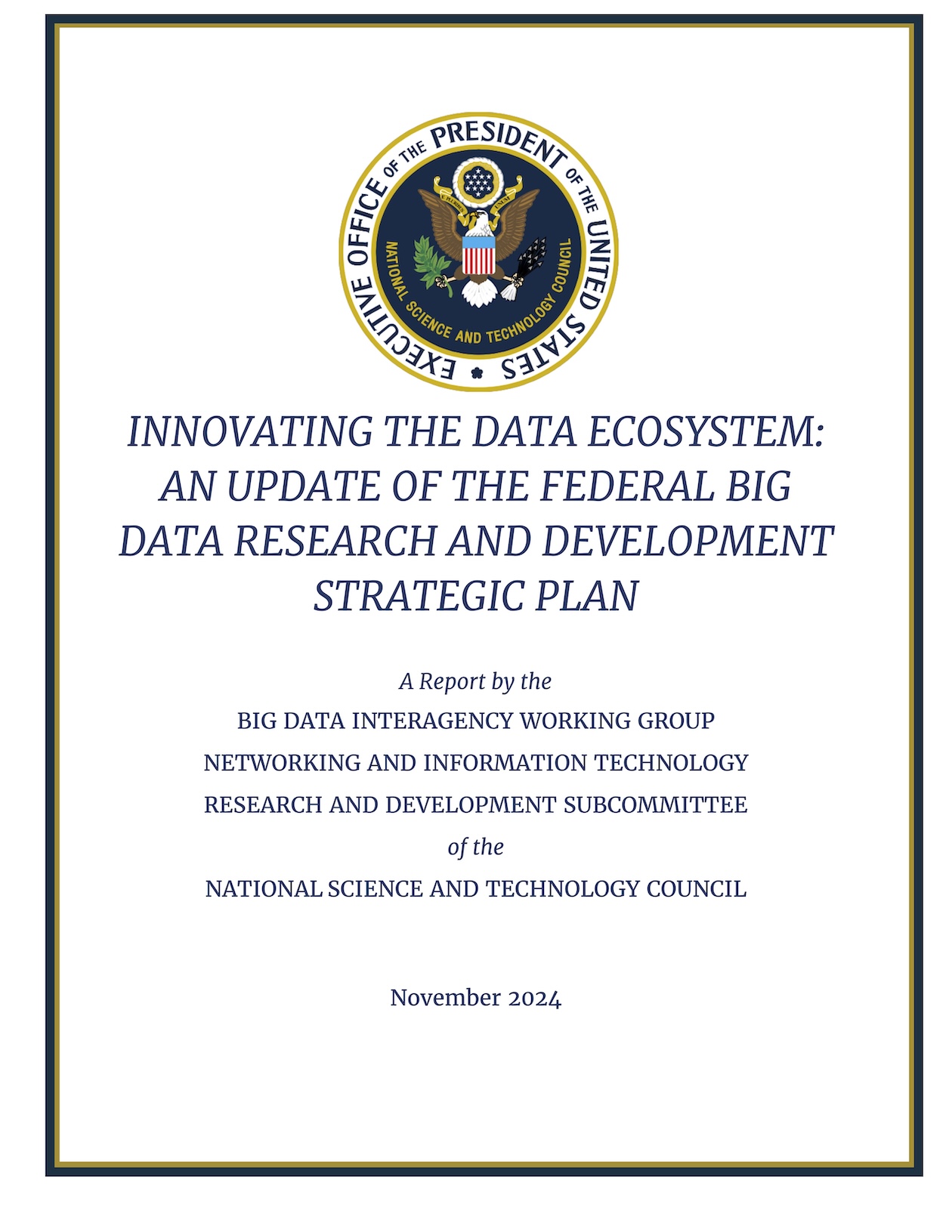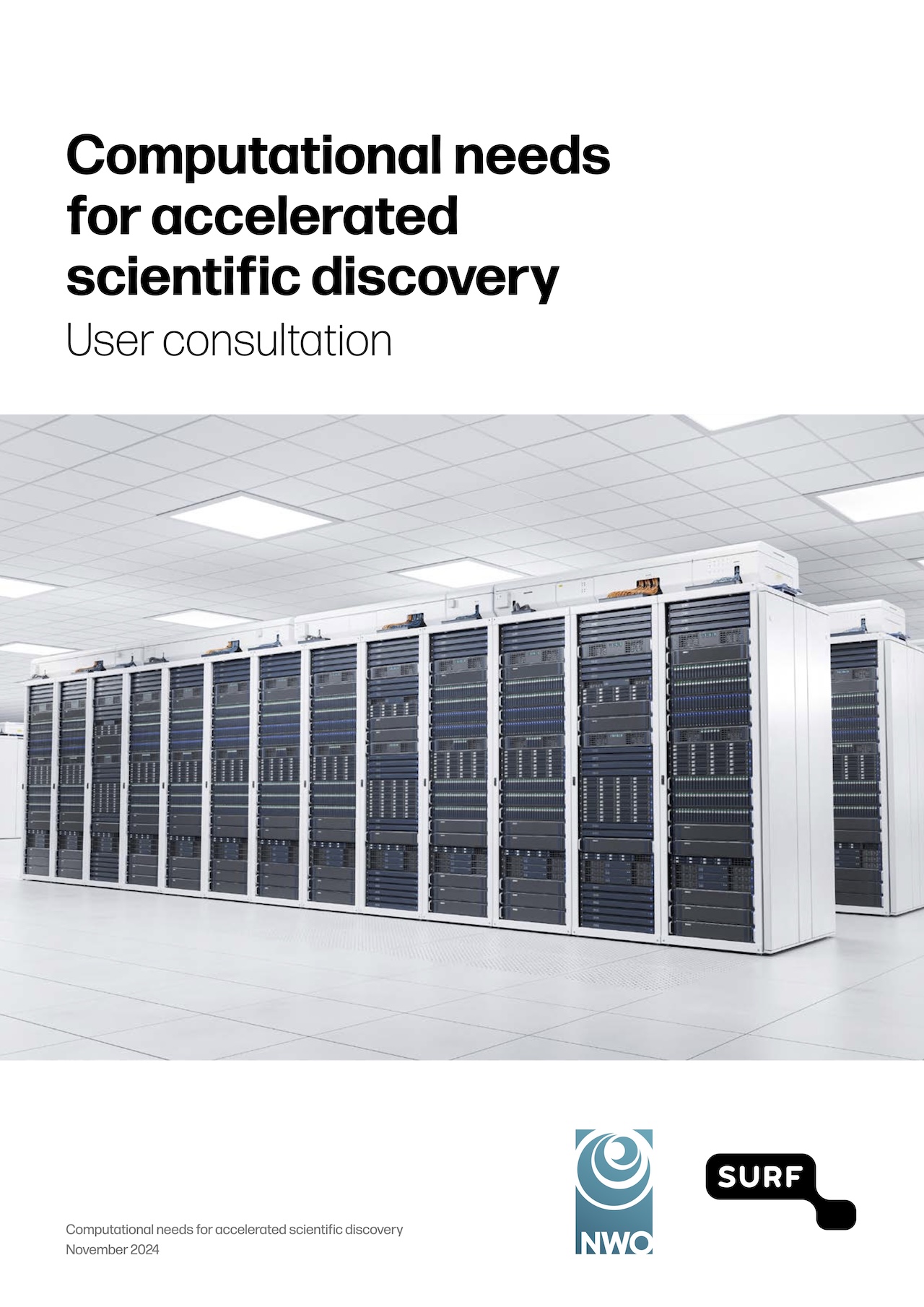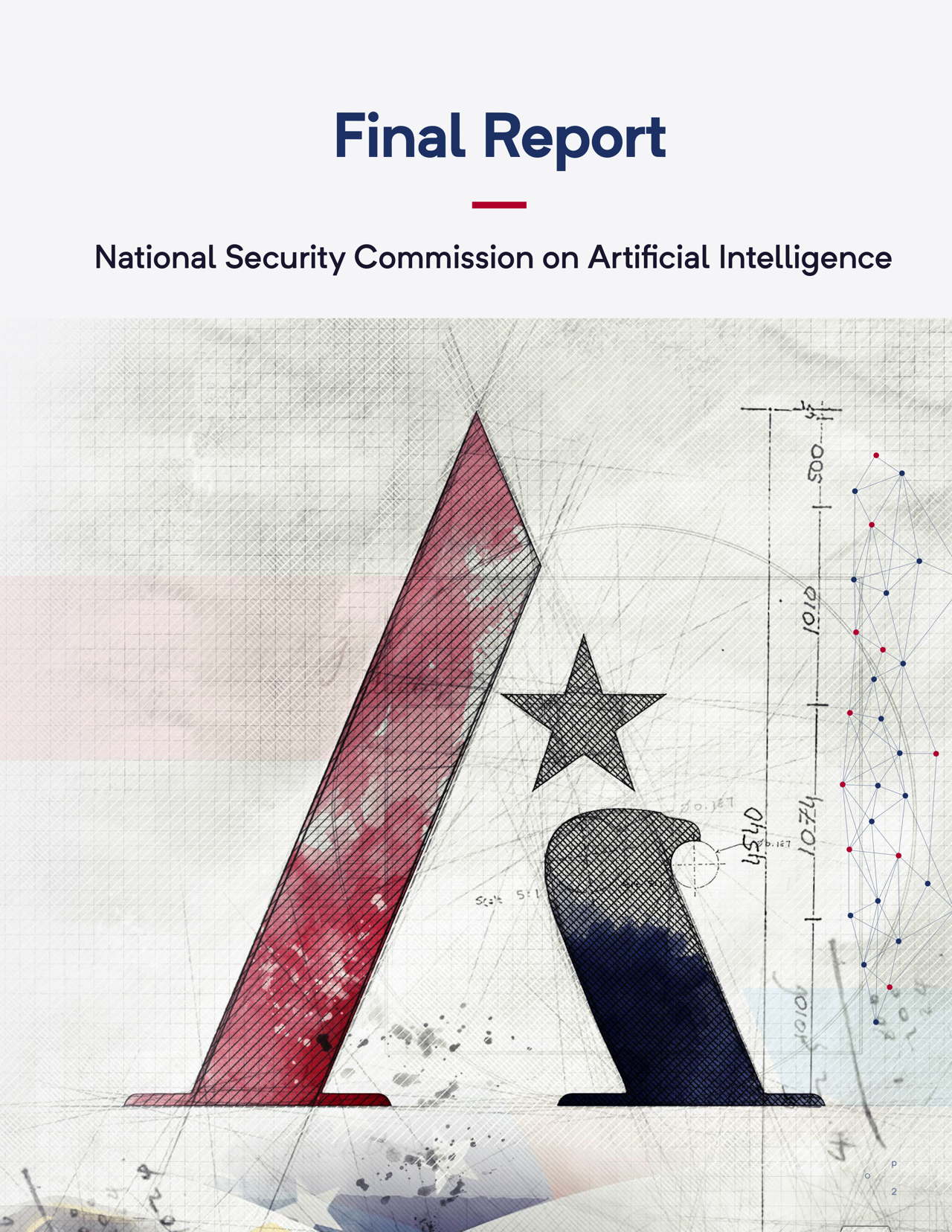
DoE, NSF, WH and other CyberInfrastructure Reports


|
DoE, NSF, WH and other CyberInfrastructure Reports
|

|
| 2024 |
 |
INNOVATING THE DATA ECOSYSTEM: AN UPDATE OF THE FEDERAL BIG DATA RESEARCH AND DEVELOPMENT STRATEGIC PLANA Report by the BIG DATA INTERAGENCY WORKING GROUP NETWORKING AND INFORMATION TECHNOLOGY RESEARCH AND DEVELOPMENT SUBCOMMITTEE of the NATIONAL SCIENCE AND TECHNOLOGY COUNCIL |
pdf |
link |
| 2024 |
 |
Computational needs for accelerated scientific discovery; User consultation, NWO and SURFIn this document, we describe the expected demand from the scientific community for computing facilities in the coming years. It also considers the impact of AI on this demand, as it will have a huge impact on methodologies and data-driven analyses in a wide range of scientific areas. This science case is based on consultations with a number of principal investigators of Dutch research groups that make extensive use of current computing facilities, and on a questionnaire distributed widely in the scientific community3, covering a range of approximately 60 scientific disciplines. The following sections describe our general findings. A more detailed account of the scientific ambitions and infrastructure needs of current users can be found in Chapter 4. Further relevant information is provided in the appendices. |
pdf |
link |
| 2024 |
 |
The future of European competitiveness; Report by Mario DraghiThe report looks at the challenges faced by the industry and companies in the Single Market. |
pdf |
link |
| 2024 |
 |
Final Report on National Security Commission on Artificial IntelligenceArtificial Intelligence (AI) technologies promise to be the most powerful tools in generations for expanding knowledge, increasing prosperity, and enriching the human experience. The technologies will be the foundation of the innovation economy and a source of enormous power for countries that harness them. AI will fuel competition between governments and companies racing to field it. And it will be employed by nation-states to pursue their strategic ambitions.Americans have not yet seriously grappled with how profoundly the AI revolution will impact society, the economy, and national security. Recent AI breakthroughs, such as a computer defeating a human in the popular strategy game of Go1, shocked other nations into action, but it did not inspire the same response in the United States. Despite our private-sector and university leadership in AI, the United States remains unprepared for the coming era. Americans must recognize the assertive role that the government will have to play in ensuring the United States wins this innovation competition. Congress and the President will have to support the scale of public resources required to achieve it. |
pdf |
link |
| 2024 CISA |
 |
Review of the Summer 2023 Microsoft Exchange Online IntrusionIn May and June 2023, a threat actor compromised the Microsoft Exchange Online mailboxes of 22 organizations and over 500 individuals around the world. The actor—known as Storm-0558 and assessed to be affiliated with the People’s Republic of China in pursuit of espionage objectives—accessed the accounts using authentication tokens that were signed by a key Microsoft had created in 2016. This intrusion compromised senior United States government representatives working on national security matters, including the email accounts of Commerce Secretary Gina Raimondo, United States Ambassador to the People’s Republic of China R. Nicholas Burns, and Congressman Don Bacon... |
pdf |
link |
| 2023 DoE |
 |
Integrated Research Infrastructure Architecture Blueprint ActivityThe complexity of scientific pursuits is increasing rapidly with aspects that require dynamic integration of experiment, observation, theory, modeling, simulation, visualization, machine learning (ML), artificial intelligence (AI), and analysis. Research projects across the Department of Energy (DOE) are increasingly data and compute intensive. Innovative research teams are accelerating the pace of discovery by using high-performance computational and data tools in their research workflows and leveraging multiple research infrastructures... |
pdf |
link |
| 2023 DoE |
 |
5G Enabled Energy Innovation: Advanced Wireless Networks for Science (Workshop Report)Rapidly expanding, new telecommunications infrastructure based on 5G technologies will disrupt and transform how we design, build, operate, and optimize scientific infrastructure and the experiments and services enabled by that infrastructure, from continental-scale sensor networks to centralized scientific user facilities, from intelligent Internet of Things devices to supercomputers. Concurrently, 5G will introduce, or exacerbate, challenges related to protecting infrastructure and associated scientific data as well as to fully leveraging opportunities related to expanded infrastructure scale and complexity... |
pdf |
link |
| 2023 WH |
 |
Strengthening and Democratizing the U.S. Artificial Intelligence Innovation EcosystemThis final report of the NAIRR Task Force presents a
roadmap and implementation plan for a national cyberinfrastructure aimed
at overcoming the access divide, reaping the benefits of greater
brainpower and more diverse perspectives and experiences applied to
developing the future of AI technology and its role in our society. |
pdf |
link |
| 2023 NSF |
 |
NSF Public Access Plan 2.0: Ensuring Open, Immediate and Equitable Access to National Science Foundation Funded ResearchNSF’s updated public access plan integrates new agency
guidance issued by the White House Office of Science and Technology
Policy in August of 2022. This guidance, which includes zero-embargo
public access for research publications and their supporting data, was
developed with leadership from the National Science and Technology
Council Subcommittee on Open Science, in which NSF has always been
actively engaged. |
pdf |
link |
| 2022 DoE |
 |
Advanced Research Directions on AI for Science, Energy, and Security.Report on the U.S. Department of Energy (DOE) Summer 2022 Workshop Series on Artificial Intelligence (AI) for Science, Energy, and Security... |
pdf |
link |
| 2022 DoE |
 |
Cybersecurity Considerations for Distributed Energy Resources on the U.S. Electric Grid.As such, this report provides an overview of cybersecurity
considerations that should be considered by the electric sector,
including utilities and distributed energy resources (DER) operators,
providers, integrators, developers, and vendors (collectively, “the DER
industry”), as well as policymakers as we embark on this
transformational change to the U.S. electric grid. This report is not
meant to be a comprehensive review of cybersecurity considerations in
the DER industry, but rather encourage a dialogue and further
conversations between industry and government stakeholders. |
pdf |
link |
| 2020 WH |
 |
A Strategic Vision for America's Quantum Networks.Quantum computing and networking technologies are still at an early stage of research and development (R&D). The strategic vision focuses America’s R&D efforts to advance the development of foundations for the quantum internet. It establishes QIS community goals for quantum networking, and recommends six specific technical areas for focused research activity. |
link | |
| 2020 DoE |
 |
From Long-distance Entanglement to Building a Nationwide Quantum Internet: Report of the DOE Quantum Internet Blueprint Workshop.A Quantum Path Forward. Today, many scientific experts recognize that building and scaling quantum-protected and enhanced communication networks are among the most important technological frontiers of the 21st century. The international research community perceives the construction of a first prototype global quantum network-the Quantum Internet-to be within reach over the next decade. In February 2020, the U.S. Department of Energy (DOE)'s Office of Advanced Scientific Computing Research hosted the Quantum Internet Blueprint workshop to define a potential roadmap toward building the first nationwide quantum Internet. The workshop participants included representatives from DOE national laboratories, universities, industry, and other U.S. agencies with serious interests in quantum networking. The goal was to provide an outline of the essential research needed, detail any engineering and design barriers, and suggest a path forward to move from today's limited local network experiments to a viable, secure quantum Internet. |
pdf |
link |
| 2020 DoE |
 |
AI for ScienceFrom July to October 2019, the Argonne, Oak Ridge, and Berkeley National Laboratories hosted a series of four town hall meetings attended by more than 1,000 U.S. scientists and engineers. The goal of the town hall series was to examine scientific opportunities in the areas of artificial intelligence (AI), Big Data, and high-performance computing (HPC) in the next decade, and to capture the big ideas, grand challenges, and next steps to realizing these opportunities. |
pdf |
link |
| 2019 DoE |
 |
Quantum Networks for Open Science WorkshopQuantum computing systems currently being developed will have extraordinary capabilities to effectively solve complex problems in computational sciences, communication networks, artificial intelligence, and data processing, and will provide a powerful capability for researchers in almost every scientific discipline. Harnessing the full potential of quantum computing will require an ecosystem with a broad spectrum of quantum technologies. Quantum networks are one of the critical and highly anticipated components of this ecosystem. The combination of quantum computing and quantum networks are crucial to the US Department of Energy’s (DOE) mission to provide scientists with the state-of-the-art computational capabilities. Here workshop materials. |
pdf |
link |
| 2019 DoE |
 |
Basic Research Needs for Scientific Machine Learning Core Technologies for Artificial IntelligenceThe report summarizes the outcomes of a January 2018 basic
research needs (BRN) workshop, which identified six Priority Research
Directions (PRDs) for Advanced Scientific Computing Re- search (ASCR) in
developing greater SciML-based capabilities for DOE mission challenges.
The workshop considered the status, recent trends, and broad use of
SciML. This information then was used to examine the opportunities,
barriers, and potential for high scientific impact through fundamental
advances in its mathematical, statistical, and computational research
foundations. |
pdf |
link |
| 2018 WH |
 |
The Networking & Information Technology Research & Development ProgramThis document is a supplement to the President’s FY2019 Budget Request to Congress. It describes activities planned for FY2019 by the Federal agencies participating in the Networking and Information Technology Research and Development (NITRD) Program. It reports actual investments for FY2017, estimated investments for FY2018, and requested funding levels for FY2019 by agency and Program Component Area (PCA). For the FY2019 budget request, this Supplement identifies the strategic priorities, key programs, and key coordination activities of each NITRD PCA. An appendix to the Supplement, FY2019 Federal Cybersecurity R&D Strategic Plan Implementation Roadmap, lists existing and proposed Federal R&D projects and programs that address the Nation’s critical cybersecurity challenges; it is available at https://nitrd.gov/pubs/FY2019-Cybersecurity-RD-Roadmap.pdf. |
pdf |
link |
| 2018 WH |
 |
FY2019 Federal Cybersecurity R&D Strategic Plan Implementation RoadmapThis document provides FY2019 implementation details for
the 2016 Federal Cybersecurity Research and Development (R&D)
Strategic Plan, pursuant to the Cybersecurity Enhancement Act of 2014,
Public Law 113-274. It lists key Federal projects and programs that
directly contribute to solving the cybersecurity challenges outlined in
the 2016 Federal Cybersecurity R&D Strategic Plan. This document
accompanies the NITRD Supplement to the President’s FY2019 Budget
Request, available at
https://www.nitrd.gov/pubs/FY2019-NITRD-Supplement.pdf. |
pdf |
link |
| 2018 NSF |
 |
Rethinking NSF’s Computational Ecosystem for 21st Century Science and Engineering (Workshop Report)This report summarizes the discussions from a workshop
convened at NSF on May 30-31, 2018 in Alexandria, VA. The overarching
objective of the workshop was to rethink the nature and composition of
the NSF-supported computational ecosystem given changing application
requirements and resources and technology landscapes. The workshop
included roughly 50 participants, drawn from high-performance computing
(HPC) centers, campus computing facilities, cloud service providers
(academic and commercial), and distributed resource providers.
Participants spanned both large research institutions and smaller
universities. |
pdf |
link |
| 2017 DoE |
 |
Smart High-Performance Networks; Towards New Generation Intelligent Networking Infrastructure for Distributed Science EnvironmentsThe vision for a “smart network” combines the programmability and ease of automation enabled by SDN technologies with AI technologies to realize network infrastructures that are self-aware, self-managing, and self-healing. The ultimate goal is a smart network infrastructure that can monitor itself, diagnose and resolve problems, defend itself from cyber-attacks, and provide intelligent services to scientists. To address these issues the DOE Advanced Scientific Computing Research (ASCR) Smart High- Performance Networks workshop brought together network researchers and operators from national laboratories, academia, and industry. The core of the workshop discussions were organized around four key technical topic areas; Smart Network Infrastructures, Smart Applications, AI-Based Technology for Smart Networked Systems, and Smart Cyber Security Sub-systems. Here workshop materials. |
pdf |
link |
| 2016 NSF |
 |
Report of the NSF Workshop on Software Defined Infrastructures and Software Defined Exchanges.Software-defined infrastructure and software-defined
exchanges (SDXes) have the potential to affect the way that we design
not only those systems, but the fundamental architecture of the Internet
itself. The purpose of this workshop was to identify transformative
research problems that must be solved before this vision can be
realized, with an eye towards research in the 2020–2025 timeframe. It
also looked at infrastructure projects that could help to catalyze this
research. Here workshop materials. |
link | |
| 2016 NSF |
 |
Looking Beyond the Internet Steering Group Final ReportThis report documents the observations and recommendations of the “Looking Beyond the Internet” Steering Group; please see Appendix A for a member list. The Steering Group effort, including its three workshops, is based upon work supported by the National Science Foundation under Grant No. 15467691. |
link | |
| 2016 WH |
 |
Technology and the Future of CitiesThis report complements and goes beyond the ideas captured
by the label, “Smart Cities, ” identifying opportunities to improve
people’s lives both by modernizing key infrastructures (such as for
energy, water, or transportation) and by using information technology
(often with open data) to enhance city operations and services. |
link | |
| 2016 NSF |
 |
Applications and Services in the Year 2021Today’s digital infrastructure is undergoing deep
technological changes and new paradigms are rapidly taking shape in both
the core and edge domains. These paradigms leverage the growing
footprint of ultra- high-speed broadband networks, pervasive wireless,
cloud computing, and software-defined infrastructure. Moreover, they are
positioned to connect smart/mobile devices, as well as their data on a
massive scale. These advances will enable transformative applications
and services in the decade beginning in 2021 that will enhance the
quality of peoples’ lives while addressing important national
priorities. In addition, these new technologies may bridge and unite
today’s cutting edge applications such as the Internet of Things, Big
Data Analytics, Robotics, The Industrial Internet, and Immersive
Virtual/Augmented Reality, yielding applications that are not obvious or
even possible at this time. |
pdf |
link |
| 2015 |
 |
ASCR Cybersecurity for Scientific Computing IntegrityAt the request of the U.S. Department of Energy’s (DOE) Advanced Scientific Computing Research (ASCR) program, a workshop was held January 7–9, 2015, in Rockville, Md., to examine computer security research gaps and approaches for assuring scientific computing integrity specific to the mission of the DOE Office of Science. Issues included research computation and simulation that takes place on ASCR computing facilities and networks, as well as network-connected scientific instruments, such as those run by other DOE Office of Science programs. |
pdf |
link |